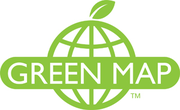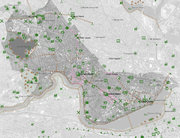
Green Map
Encyclopedia

Green Maps are locally created environmentally themed maps which use a universal symbol
Symbol
A symbol is something which represents an idea, a physical entity or a process but is distinct from it. The purpose of a symbol is to communicate meaning. For example, a red octagon may be a symbol for "STOP". On a map, a picture of a tent might represent a campsite. Numerals are symbols for...
set and mapmaking resources provided by the non-profit Green Map System. Based on the principles of cartography
Cartography
Cartography is the study and practice of making maps. Combining science, aesthetics, and technique, cartography builds on the premise that reality can be modeled in ways that communicate spatial information effectively.The fundamental problems of traditional cartography are to:*Set the map's...
a Green Map plots the locations of a community's natural, cultural and sustainable resources such as recycling centers, heritage sites, community gardens, toxic waste sites and socially conscious businesses.
Purpose
The purpose of a Green Map is to serve as a guide for sustainable livingSustainable living
Sustainable living is a lifestyle that attempts to reduce an individual's or society's use of the Earth's natural resources and his/her own resources. Practitioners of sustainable living often attempt to reduce their carbon footprint by altering methods of transportation, energy consumption and diet...
and to help everyone get involved with their community’s natural and man-made environment. Using mapmaking as a medium, Green Map System encourages involvement in cultivating more sustainable communities around the world. By highlighting a community’s special places as well as its natural, cultural and sustainability resources, Green Map expects to help local citizens understand their community’s interdependent environmental, social and economic systems. Green Maps provide residents, newcomers and visitors a guide to local green options, they can also bring attention to the negative sites that challenge community well-being. Mapmakers share adaptable mapmaking resources and universal icons.
Tagline
The Green Map tagline is “Think Global, Map Local!”. It’s a play on the familiar think global - act local, and implies the same depth of local involvement for positive change.Green Icons
All Green Maps use a set of globally designed Green Icons, developed collaboratively by the network of local project leaders. Allegedly this is the world’s only universal symbol set for maps. The globally designed icons ensure that all Green Maps engage and guide a diversity of users. Because concepts of sustainability are continually evolving, Green Mapmakers have developed the third version of the symbols, released in march 2008. Provided as a font for ease of use or as stickers for youth/computerless Green Mapmakers.Greenhouse
The website GreenMap.org is the gathering point for both the makers and the users of Green Maps. GreenMap.org went online in 1995 and it was re-launched in May 2007, with a resource center for Mapmakers all over the world to communicate and exchange their Green Map making experience. This content management system is named as GreenhouseGreenhouse
A greenhouse is a building in which plants are grown. These structures range in size from small sheds to very large buildings...
, symbolizing its ability to cultivate and present a “garden of Green Maps”.
Structure

Mapmaking Process
Although Green Map System authorizes local mapmakers to use its Green Mapmaking icons and tools, every project is independent and locally-led. Grassroots and established non-profits, universities and schools, governmental and tourism agencies use the icons and adaptable methodologies to develop and publish their own community's Green Map in a way that meets the needs of residents and visitors.Impacts & Developments

Over 325 Green Maps have been published, including 80 online editions.
Awards and articles include local, national and international recognition.
History
Green Maps are an educational and environmental communication tool for advocacy and public awareness first created for New York City by eco-designer Wendy Brawer of Modern World Design in 1992 as seen at the Green Apple Map website. The global Green Map System was formed as a result of the response to this first Green Map. Since 1995, Green Mapmaking has grown steadily around the world.Branding and spelling
While Green Map System prefers and promotes the spelling "Green Map" to preserve trademark claims,"green map" and "greenmap" are often used by local Green Map projects. Green Map System is concerned with maintaining control of copyright and trademark in order to preserve the perceived integrity of the system; they wish to prevent the use of Green Maps in greenwash
Greenwash
Greenwashing , or "green sheen", is a form of spin in which green PR or green marketing is deceptively used to promote the perception that a company's policies or products are environmentally friendly.-Usage:...
ing and do not allow public use of their assets.
External links
- Green Map System
- Green Map Atlas, an anthology of mapmaking stories
- Jerusalem Post's article on The Greening of Jerusalem, 2006
- Grist.org's article on Make Me A Map, 2006

